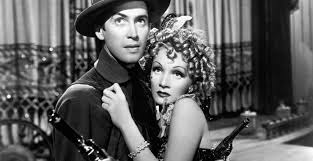 |
| Donald Ogden Stewart |
When people talk about films starring Katharine Hepburn and Spencer Tracy, they seldom mean the 1942 Keeper of the Flame. One might think that its stars, with George Cukor as director and screenwriter Donald Ogden Stewart of Philadelphia Story fame, would rate at least a small measure of respect. So complete has been its eclipse, however, that not even the most engagé Australian critics have risen to the fact that Ida Alexa Ross Wylie, author of the original novel, was Melbourne-born, and enjoyed a prominent public profile as both lesbian and suffragette.
The message of Keeper of the Flame was timely. In June 1941, twenty thousand people assembled at the Hollywood Bowl to hear isolationist Charles Lindbergh urge that America keep out of the war. Don Stewart, then president of the Hollywood Anti-Nazi League, the American League of Writers and the Anti-Franco League (“I loved being president,” he confessed once, with one of his cat-like smiles),was easily persuaded to join closet leftists Tracy and Hepburn in suggesting that a heroic figure like Lucky Lindy might become the figurehead of a Fascist takeover of the United States. In December of that year, Pearl Harbor rendered the argument irrelevant but in certain quarters commitment to the war remained grudging.
 |
| Katharine Hepburn |
Wealthy, feted, the epitome of trivial humour, Stewart made an improbable leftist. He dated his transformation from 1936. That spring, he came, as usual, to London to refresh his wardrobe. He also did a little work. “I was writing a play and it had a Communist in it,” he said. “I didn’t have any idea of how tall Communists were, so I asked the doorman at Claridge’s, where we were staying, if he knew anything about Communism. He said ‘No, sir,’ but directed me to a book shop. I bought John Strachey’s The Coming Struggle for Power and read it going back on the boat. It was a revelation to me. When I got back to America, I started boring friends about Socialism. I knew I was boring them because I didn’t get invited to as many parties as I once had.”
At Hawes and Curtis, London’s best formal-wear shop, he had bought a dozen stiff shirts, a dozen soft evening shirts, and six black bow ties, in expectation of a lively season. “You know,” he told me, a little forlornly (and without, I’m sure, a grain of truth) “I still have a few of those shirts? They’re a bit yellow, but mostly unworn.”
The premiere of Keeper of the Flame at New York’s Radio City Music Hall didn’t go well. “I’m told Louis B. Mayer stormed out,” Stewart said. “I certainly hope it’s true.” Those who stayed were troubled by a niggling sense of déjà vu. After a newsreel documenting the death of a significant figure in American public life, reporters gather for the funeral at his grim walled estate, while a lone journalist sets out to investigate his secret life. Hadn’t they seen all this before? For once, Hedda Hopper seemed to have got it right when she called it “Citizen Kane with all the art scraped off."
There’s still plenty of art to go around, though not of the Wellesian variety. Cinematographer William Daniels shuns the flamboyance of Gregg Toland, opting for the high-key formalism he did so much to perfect in his films for Garbo. Shot entirely on interiors, Keeper of the Flame is MGM precision incarnate, investing its characters with the same immobility as the furniture that fills the mansion’s vast rooms.
 |
| Spencer Tracy |
Tracy as the reporter, Hepburn as the widow and Richard Whorf as the dead man’s secretary navigate the decor as formally as chess pieces, with Hepburn, often dressed in soft draped white, as the omnipotent queen. If she’s the queen, the treacherous Whorf, oleaginous and peremptory by turns, is a side-sliding bishop, while Tracy, hat brim so sharply turned down as to resemble a visor, and tending always to the awkward and oblique move, must be the knight. In that capacity, he woos the widow into a confession that she let her husband drive over a demolished bridge rather than let him take the first steps in a coup d’etat.
 |
| Richard Whorf, Katharine Hepburn |
Cukor directs in Gaslight mode, but rather than Charles Boyer lowering over a shuddering Ingrid Bergman, Tracy, soft-eyed and low-voiced, sits at the knee of Hepburn as she stares over his head, eyes glowing with the receding glory of her dead hero. Bronislau Kaper’s discreet score is no match for such images. They demand Wagner.
RKO owned the novel first, and planned a modest thriller more in keeping with its discreet political subtext; something for Robert Mitchum or Joel McCrea perhaps, and Laraine Day. With memories, however, of Citizen Kane, the rock that sank the regime of George Schaefer, they willingly relinquished it to MGM, where folie de grandeur stalked the halls. Producer Victor Saville, recently arrived from Britain, had less to do with the film than Tracy, Hepburn and Stewart, who seized the reins and confidently directed it to the left.
Cukor didn’t argue. The film was made, he said later, "during a period of undercover Fascism in the country. Certain things were in the air but hadn’t come out into the open. I suppose, to draw attention to them, we exaggerated." He, like Tracy and Hepburn, could afford to, since his value to MGM rendered him fireproof, but Stewart’s career never recovered. In 1950, he fled, blacklisted, to England – “not caught,” he said with rueful precision, “but caught up with.” Among his numerous credits, this was the one of which he was most proud. A keeper of the flame to the last.






















